Entering the world of guitars can be a daunting process, especially acoustics! What size should I get? Which tonewoods or brands are best? What’s my style? So many questions! But don’t sweat it because we’ve compiled a list of 11 excellent acoustic guitars for beginners to get you strumming and picking like a pro.
Choosing the right instrument can make all the difference in how easy it is to play, how it sounds, and how likely you are to continue working on your technique. This list has been carefully put together based on the quality, affordability, and playability offered by each model, helping you identify the perfect place to start your musical journey.
As you go through the list, remember to take note of the size of the instrument, neck profiles and body shapes, and tonewoods. We’ll go into more detail on this later in the article!
If you’re after guitars specifically under £1,000, check out the video below.
Our top picks
Here are our top five choices to get you going ASAP.
| Hartwood Prime Single Cutaway | An affordable guitar with a solid top, cutaway for playability, and D'addario strings - it's ready to gig! | Check the current price |
| Yamaha F310 | Made with a durable laminate build, this budget-friendly guitar sounds great and will only sound better with age! | Check the current price |
| Fender DE FA-135 Concert All-Mahogany | A comfortable concert body shape is great for any size of player, and the natural mahogany finish looks stunning as well. | Check the current price |
| Takamine GX11ME Taka-Mini Travel Electro Acoustic | Super easy to carry, travel, and play, the Taka-Mini's integrated electronics allow you to perform and record with ultimate ease. | Check the current price |
| Luna Art Vintage Dread Solid Top Distressed Acoustic | With its solid top and beautiful distressed finish, this guitar boasts rich sounds and a pretty cool aesthetic. | Check the current price |
Best acoustic guitars for beginners
1. Fender DE FA-135 Concert, Natural
A gorgeous mahogany finish bestows this comfortable concert-sized guitar a premium look and durable construction.
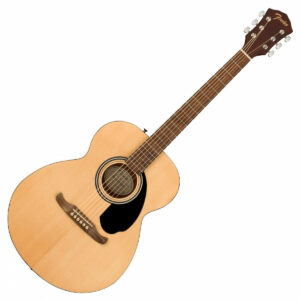 Top: Laminated Mahogany
Top: Laminated Mahogany- Back and Sides: Laminated Mahogany
- Neck: Nato
- Fingerboard: Walnut
- Bridge: Walnut
- Nut Width: 1.69″ (43 mm)
- Scale Length: 25.3″ (643 mm)
- Number of Frets: 20
- Tuning Machines: Open Gear
- Electronics: None
- Finish: Satin
| Pros | Cons |
| Easy and comfortable to play thanks to concert body | Some players may prefer a larger dreadnought shape |
| Affordable | No built-in electronics |
| Mahogany aesthetics | Not a solid wood top |
| Great for both fingerpicking and strumming | Lacks the volume and bass of larger acoustics |
An excellent introduction to beginner guitars, the Fender DE FA-135 Concert covers all the bases: it’s comfortable and easy to play, looks great, and produces fantastic, tonally balanced sounds.
The concert body shape is ideal for guitar newcomers as it’s smaller than a dreadnought but larger than a parlour or travel guitar.
This slim size is easy to hold and play for extended periods of time and means you can put less effort into strumming, fingerpicking, and fretting notes. Sonically speaking, it’s neither too boomy nor too bright – you can try out virtually any style or genre with great effect.
In terms of volume, the Fender FA-125 is loud enough for smaller venues and intimate gigs, but if you’re playing with an ensemble, it will most likely need mic’ing up.
Plus, the FA-135’s laminate construction means it’s both affordable and durable.
The layered material design results in reduced weight and excellent structural rigidity – boosted by a complete resistance to humidity and temperature damage. This is ideal for the learning guitarist; you want to be able to travel, store, and play your instrument with minimal maintenance.
And speaking of minimal maintenance, the modern-style Fender headstock coupled with a cool Viking-inspired bridge ensures an even string tension for maximum tuning stability.
The nato set-in neck is also a slim and slender carve, and it’s combined with the low string action to create a smooth and fluid playing experience in which it’s a breeze to press down on the strings. You’ll find those tricky chords much easier to pull off when compared to thicker neck profiles.
Shop now | Fender DE FA-135 Concert, Walnut Fingerboard, Natural
2. Classical Electro Acoustic Guitar, Natural, by Gear4music
Affordable and highly versatile, this classical electro gives you the sweet nylon string voice and the ability to play both acoustically and amplified!
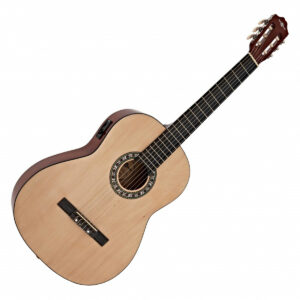 Body Wood: Linden laminate
Body Wood: Linden laminate- Top Wood: Spruce laminate
- Neck: Maple
- Fingerboard: Blackwood
- Scale Length: 25.5”/648mm
- Pickup: Undersaddle Piezo
- Preamp: 2-band EQ and volume control
| Pros | Cons |
| Affordable price point | Linden laminate body wood may not provide the same tonal richness as solid wood |
| Built-in electronics allow for amplified playing | Some players may prefer a more traditional classical guitar without electronics |
| Classical guitar body shape is comfortable and familiar for players | Nato neck may not be as durable as other woods |
Classical guitars are a great starting point for any guitarist. It’s a common entry instrument for students (including myself!) for its lightweight, flat fretboard radius that opens to a number of playing styles and comfortable body shape.
The generally smaller size of classical Spanish-style guitars – and the Gear4Music Electro Acoustic Classical in particular – make it easier to develop good playing habits for your guitar career. Things like the correct method of fingering chords, learning to pick rhythmically, and building dexterity will all grow naturally.
And sonically, there’s a bright character enhanced by the warm response of nylon strings. Traditionally, it’s perfect for flamenco and classical arrangements, but don’t feel restricted! The soft voice of Gear4Music Classical Electro works for jazz, blues, and rock, especially with its amplified tones using the built-in electronics.
On the subject of amplification, you can easily boost your sound thanks to the integrated preamp on the Classical Electro. Granting a natural and warm replication of the acoustic tone, the preamp lets you perform without sacrificing quality.
There’s even a 2-band EQ with volume control to shape your sound, and a tuner and phase switch ensure your pitch and output is always on point.
But what about unplugged? Well, the smaller shape and nylon string material mean it’s great for solo practice without being overly loud but might require amplification at performances (where the preamp comes in handy!)
All these sounds stem from the spruce and linden laminate construction. The spruce provides focus and articulation with each note, while the linden basswood rounds out the tone with extra low end. As they’re both laminate materials on this budget-focused guitar, you can expect exceptional durability, which is ideal for players carting their guitar to and from practice sessions and lessons.
Shop now | Classical Electro Acoustic Guitar, Natural, by Gear4music
3. Yamaha F310 Acoustic Guitar
Big dreadnought sounds, easy playability, and top-tier Yamaha build quality make the F310 a great choice for any lover of steel string guitars.
- Body Wood: Laminated Spruce top, Meranti back and sides
- Neck: Nato wood
- Scale length: 25 inches
- Pickups: None
- Tuners: Die-cast Chrome
- Bridge: Rosewood
- Fretboard: Rosewood
- Number of Frets: 20
| Pros | Cons |
| Well-balanced tone with good projection | The laminated wood may not offer the same tonal quality as solid wood guitars |
| Stays in tune well | The lack of a pickup may limit its versatility for those interested in amplified playing |
| Great build quality | The larger dreadnought size might be uncomfortable for younger players |
| Slim neck design for easy playing |
One of the standout choices you’ll see in many beginner guitar guides, the Yamaha F310 sets itself apart for its exceptional build quality, easy playability, and premium satin finish. With a tough ultra-thin lacquer applied to the spruce top, it enhances the vibration of the soundboard to squeeze out every ounce of tone from your notes.
And those notes are wonderfully balanced, with a rounded sonic profile that boasts a warm mid-range, rich and rumbling lows, and clear highs. This makes it an excellent strummer guitar for aspiring singer-songwriters or even those searching for a classic steel string tone.
Like most other dreadnoughts, it’s versatile enough to suit a range of playing styles, from strummed chords to fingerpicked melodies. On the F310, those playing styles are much easier to develop thanks to its slim neck carve that lets you press down notes and grip the fretboard with much less effort or strain.
Whatever genre you decide to play, it’ll be voiced with plenty of volume. The imposing dreadnought shape gives you loads of power to be heard playing unplugged, whether that’s at a campfire or an open mic night! But as it lacks integrated electronics, you’ll need a microphone if you need it amplified.
Another top feature of the F310 is its affordable price point matched with Yamaha’s exceptional quality.
That’s backed up by the laminate spruce top and meranti back and sides which guarantee long-lasting durability. Laminate materials sacrifice the rich tone of solid woods but enjoy much greater resistance to humidity and moisture damage – so if you’re taking it on your travels, you can do so without worry!
Shop now | Yamaha F310 Acoustic Guitar, Natural
4. Fender FA-125CE Dreadnought Electro Acoustic WN, Natural
Powerful dreadnought voice with a playability-enhancing cutaway, great tuning stability, and excellent Fender electronics to amplify your acoustic tone.
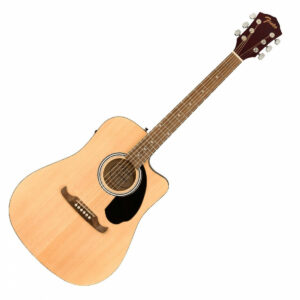 Body Shape: Dreadnought Cutaway
Body Shape: Dreadnought Cutaway- Top Wood: Laminated Spruce
- Back and Sides Wood: Laminated Mahogany
- Neck Wood: Nato
- Fingerboard: Walnut
- Scale Length: 25.3″ (643mm)
- Nut Width: 1.69″ (43mm)
- Electronics: Fender FE-A2 preamp with built-in tuner
- Tuners: Die-cast sealed
- Bridge: Walnut
| Pros | Cons |
| Solid build quality and attractive natural finish | The laminated wood construction may not have the same tonal depth and resonance as solid wood options |
| Powerful and full sound with great projection | Some players may prefer a wider neck width for fingerstyle playing |
| Built-in Fender preamp and tuner allow for amplified playing | |
| Playability-enhancing cutaway design for easier access to upper frets |
What better place to start than Fender? A name recognisable to non-guitar players everywhere, Fender’s massive range of beginner-focused instruments has everything a newbie needs to get started.
The FA-125 CE is the perfect example, offering classic steel string tones with a couple of modern updates to satisfy any player.
Boasting a warm and full sound that is well-suited to a variety of genres and playing styles, you’re going to develop all the skills you need to succeed. That includes strumming and fingerstyle playing in addition to building finger strength for those tricky chords.
To help with this, the action is comfortable and beginner-friendly, making it easier for newer players to nail those complex passages.
The laminated spruce top and laminated mahogany back and sides produce a balanced tone that is both clear and resonant. Plus, there’s plenty of natural volume thanks to the dreadnought body shape. If you’re playing acoustically, you’ll have plenty of power to work with, but, if you need extra juice then the built-in electronics have you covered!
Equipped with Fender’s FE-A2 preamp and built-in tuner, the FA-125 CE projects a natural tone when amplified, which you can shape using the intuitive Tone dial.
The tuning stability on this guitar is excellent, thanks to the die-cast sealed tuners, which keep the strings in tune even during extended playing sessions. Combined with Fender’s cool Viking inspired bridge you’ll enjoy an accurate intonation and minimal maintenance while advancing your skills on this comfy guitar.
Talking of comfy, the cutaway design sits nicely in your lap for seated playing, and enables unhindered access to those upper frets – encouraging you to get as creative as possible during your playing!
Shop now | Fender FA-125CE Dreadnought Electro Acoustic WN, Natural
5. Deluxe Dreadnought Acoustic Guitar by Gear4music, Mahogany
Highly affordable with large dreadnought tones and an impeccable vintage appearance – showed off by its sunburst finish.
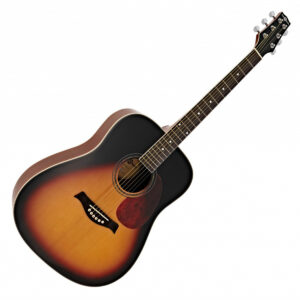 Body: Basswood
Body: Basswood- Top: Spruce
- Neck: Nato
- Fingerboard: Thermally Treated, Oiled Poplar Laminate
- Scale length: 25.5”
- Bridge: Thermally Treated, Oiled Poplar Laminate
- Tuners: Die-cast chrome
- Nut Width: 43mm
- Number of Frets: 21
- Binding: Cream
- Finish: Natural Gloss
| Pros | Cons |
| Inspiring vintage-style sunburst finish | Lacks electronics for amplified playing |
| Basswood body and spruce top combination offer a warm and full tone | Large dreadnought body shape and lack of cutaway may be difficult to pick up for younger or smaller players |
| Affordable price point |
Looking for something with a vintage flair? Want to inject your playing with a cool bluesy drawl? Why not start with this attractive Deluxe Dreadnought Acoustic by Gear4Music? It offers a superb aesthetic not often found in this price range and is highly affordable for any budget.
It’s an excellent choice for beginner guitar players seeking powerful acoustic tones thanks to its classic dreadnought design, which is known for its full-bodied sound and versatility across different genres.
Thanks to this, you’re able to dive into any sound that takes your fancy. From country to modern pop, the Deluxe Dreadnought is the ideal platform to start. That said, with such a cool Sunburst aesthetic, you’ve got to try out some bluesy licks!
The basswood body and spruce top are a popular combination on guitars thanks to the sweet tonal balance they provide. Spruce captures the high-end detail while basswood rounds out the sonics with warm and mellow lows, meaning your chords will sound rich and full and your leads and melodies will cut through a mix.
Added to this tone profile is plenty of volume on tap thanks to its dreadnought shape, meaning you’ll be heard at smaller gigs and ensemble sessions.
The guitar also features a comfortable neck profile, making it easy to play and manoeuvre around the fretboard and play with greater fluidity. Speaking of the neck, it’s made from sapele mahogany and coated with a smooth satin finish, enabling you to get speedier transitions between notes and chords.
In terms of tuning stability, the Gear4music Deluxe Dreadnought Acoustic has die-cast chrome tuners that hold their tuning well, ensuring the guitar stays in tune for longer periods of playing. Additionally, the tortoiseshell pickguard adds a touch of visual appeal to the guitar to accent that classy sunburst style.
While the guitar lacks electronics for amplified playing, it’s still a great option for beginners who want to focus on acoustic playing, and it’s extremely affordable!
Shop now | Deluxe Dreadnought Acoustic Guitar by Gear4music, Mahogany
6. Takamine GX11ME Taka-Mini Travel Electro Acoustic, Natural
A travel-sized electro-acoustic guitar that offers great tone, playability, and portability, making it an ideal choice for musicians on the move.
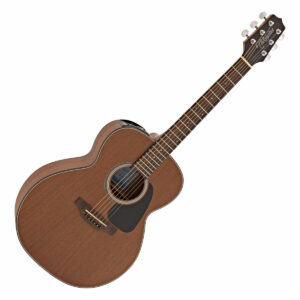 Body Shape: Mini Jumbo
Body Shape: Mini Jumbo- Top: Mahogany
- Back and Sides: Mahogany
- Neck: Mahogany
- Fingerboard: Rosewood
- Scale Length: 22.5 inches
- Nut Width: 1.6875 inches
- Preamp System: Takamine TP-4T with Built-In Tuner
- Bridge: Rosewood
- Finish: Natural Satin
| Pros | Cons |
| Portable and lightweight design makes it great for travel | Smaller size may not produce the same level of volume and projection as a full-sized acoustic guitar |
| Solid construction and quality materials produce a balanced and full sound | Limited tonal variety compared to larger acoustic guitars |
| Shorter scale length and narrow nut width make it easier for beginners and players with smaller hands to play | |
| Comes with a padded gig bag for added protection during travel |
The Takamine GX11ME Taka-Mini Travel Electro Acoustic is an excellent choice for beginners and players on the move.
As the name suggests, it features a scaled-down jumbo-style body and a shorter scale length to make it much easier to transport. And it not only makes it easier to carry but also much easier to pick up and learn!
Shorter scale guitars like the Taka-Mini have shorter gaps between frets and narrower necks, allowing you to fret difficult chords and get those tricky finger stretches perfected.
Tonally, the GX11ME offers a bright and clear sound thanks to its smaller body shape which works great with fingerpicking and twangy styles. As for flowing chords, you won’t get quite the same presence or volume as a larger acoustic guitar, but the all-mahogany construction helps introduce extra low-end and body to your sound.
The Takamine TP-4T preamp system with built-in tuner provides easy amplification and tuning, allowing you to connect to PA systems or digital interfaces for performing and recording. And that’s handy because the unplugged volume of this Takamine will struggle to be heard over an ensemble, but that also means you won’t upset your neighbours too much with excess noise!
The Takamine GX11ME Taka-Mini is well-suited to a variety of genres, including folk, country, and blues. The guitar’s smaller size and portability also make it a great option for playing at home or on the go. And there’s a padded gig bag included for added protection and easier transportation.
Shop now | Takamine GX11ME Taka-Mini Travel Electro Acoustic, Natural
7. Hartwood Prime Single Cutaway Acoustic Guitar, Natural
Affordable with high-quality components. A solid spruce top, large cutaway design, and premium D’Addario strings combine to create a great value package that’s well suited to beginners.
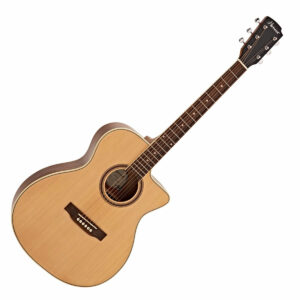 Body Wood: Solid spruce top, laminated sapele back and sides
Body Wood: Solid spruce top, laminated sapele back and sides- Neck: Okoume
- Scale Length: 25.5″
- Fretboard: Poplar laminate
- Bridge: Mahogany
- Nut Width: 43mm
- Tuners: Die-Cast Chrome
- Strings: D’Addario EXP coated
| Pros | Cons |
|
Affordable
|
Body wood may not be as high-quality as solid wood alternatives |
| High-quality strings included | No integrated electronics for amplified playing |
| Comfortable and playable neck profile | Cutaway shape might not to a classic enthusiast’s tastes |
| Solid spruce top for exceptional tones and projection |
The Hartwood Prime Single Cutaway Acoustic Guitar is a fantastic instrument for beginners. Why? It offers superb value for money, excellent playability and developed, sparkling tones – that’s why!
The Hartwood’s impressive specs include a solid spruce top to give a rich and clear tone and an articulate projection – this is super important as the guitar doesn’t have integrated electronics for amplified performing.
The high-quality spruce gives your notes excellent clarity whether you’re playing hard or soft, meaning you can strum with passion or delicately fingerpick.
And those clear tones will be rich in character thanks to the auditorium-style body shape. It gives you plenty of acoustic volume to work with, as well as a powerful midrange and bass served up by sapele back and sides.
The guitar has a comfortable neck profile that makes it easy to play and build your skills on, and with quality die-cast chrome tuners offering excellent tuning stability, you won’t have the hassle of constant retuning after every practice session. Better still, the action is set up out of the box, and the guitar is well-suited to a range of genres and playing styles.
The size of the guitar is standard for an acoustic, in between the imposing dreadnought and smaller concert and parlour shapes, making it a good choice for both beginners and more experienced players. It also features a cutaway, providing easy access to upper frets for solos and lead playing.
Shop now | Hartwood Prime Single Cutaway Acoustic Guitar
8. Luna Art Vintage Dread Solid Top Distressed Acoustic Guitar
Big dreadnought sounds accented by a unique distressed finish – perfect for a vintage vibe
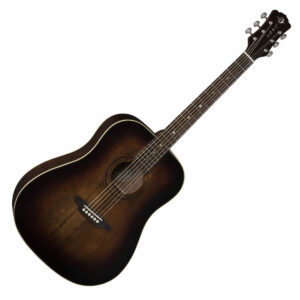 Body Shape: Dreadnought
Body Shape: Dreadnought- Top: Solid Spruce
- Back and Sides: Mahogany
- Neck: Mahogany
- Fretboard: Rosewood
- Scale Length: 25.5″
- Nut Width: 1.6875″
- Bridge: Rosewood
- Tuners: Die-cast
- Finish: Distressed Vintage Brownburst
| Pros | Cons |
| Unique vintage aesthetic | Distressed finish may not be to everyone’s taste |
| Solid spruce top for rich, warm tones | Some players may prefer a brighter, more modern sound |
| Affordable price point for a solid top guitar | |
| Die-cast tuners for good tuning stability |
Love the look and style of vintage acoustics that have been played for decades? Well, you don’t have to go trawling around antique shops or second-hand dealers, because the Luna Art Vintage Dread Solid Top gives you that sophisticated look with a playability and price that’s excellent for a beginner.
Equipped with a high-quality solid spruce top you can expect superb clarity and articulation in its sound – a sound that’ll only get better as the wood ages. Spruce is renowned for its superb projection and pristine high-end tone, so you’ll get maximum detail when practising lead lines and melodies.
As for the mid-range and low-end bass, the laminate mahogany back and sides and dreadnought body shape deliver a big and bold sound that’s well-suited to strumming, flatpicking, and fingerpicking. It also delivers plenty of volume at your command, allowing you to play to small audiences without the aid of a microphone.
Not only does it look and sound great, but the Luna Art Vintage Dread lets you focus less on maintenance and more on playing thanks to its quality open gear tuners. They’ll keep a tight grip on your strings to prevent your pitch from slipping too much, promoting great stability while also adding to the retro aesthetic.
And with a rosewood fretboard providing a smooth surface to play upon you’ll find note transitions to be swift and easy.
Shop now | Luna Art Vintage Dread Solid Top Distressed Acoustic Guitar
9. Epiphone J-45 Studio Acoustic (AJ-220S), Natural
The legendary Gibson J-45 in a much more affordable price point – perfect for beginners looking for prestige quality and tones. Even better, the Studio version features a thinner body shape for greater playability.
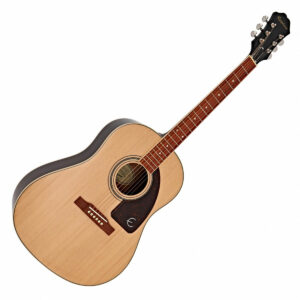 Body Shape: J-45
Body Shape: J-45- Top Material: Solid Sitka spruce
- Body Material: Mahogany
- Neck Material: Mahogany
- Fingerboard Material: Pau Ferro
- Scale Length: 25.5″
- Number of Frets: 20
- Nut Width: 1.69″
- Bridge Material: Rosewood
- Pickups: None
| Pros | Cons |
| Solid Sitka spruce top provides excellent tone and projection | No pickups or electronics included, limiting its versatility for live performances |
| Classic J-45 body shape looks great and is easy to play | Sloped shoulder style might not be to everyone’s tastes |
| Slim taper neck profile offers comfortable playability |
The legendary J-45 shape is one of the mainstays of the acoustic world. Since the 1940s, it’s a guitar that’s garnered a glowing reputation for its sublime tones and elegant aesthetic – and now this prestigious piece of history is available in an affordable model for beginners!
Introducing the Epiphone J-45 Studio, a guitar that gives you the look and feel of an icon at a price that won’t break the bank.
Elements like the solid Sitka spruce top and SlimTaper neck profile ensure you get the stellar sounds and eminent playability of a true Gibson without the associated price tag. That Sitka spruce top ensures immaculate clarity in the high-end notes as well as superb resonance and reaching projection.
Mahogany back and sides then inject warmth and richness into your sonics. Together, they create a balanced tone that’s well suited to bold chording and nimble fingerpicking.
Speaking of chords – you’ll get plenty of volume from the J-45 body shape. It’s a bit smaller than a dreadnought thanks to its sloped shoulders and thinner studio profile, but that makes it great for beginners! You’ll find it comfortable to hold while still enjoying a powerful sound.
The J-45 Studio also makes playing feel smooth and effortless through its SlimTaper neck. This tapered design allows your fingers space on the board, helping you gain finger strength and dexterity.
The Epiphone AJ-220S also offers excellent tuning stability thanks to its high-quality premium tuners and solid construction. This means that beginners can focus on learning and practising, without having to worry about constantly re-tuning their guitar.
While the guitar does not come with any pickups or electronics included, this is not necessarily a drawback for beginners who are primarily focused on learning and playing at home.
Shop now | Epiphone J-45 Studio Acoustic (AJ-220S), Natural
10. Junior 1/2 Classical Guitar, Natural, by Gear4music
Designed specifically for younger students, this half-size classical is approachable for any level or age of player.
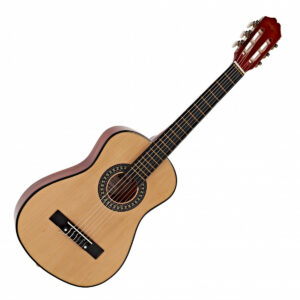 Body: Linden Laminated
Body: Linden Laminated- Neck: Ebonised Maple
- Fingerboard: Ebonised Maple
- Scale Length: 22″/ 559mm
- Frets: 18
- Nut Width: 40mm
- Strings: Nylon
| Pros | Cons |
| Designed specifically for young beginners | Small size may not be suitable for larger or older beginners |
| Lightweight and easy to handle | Tone may not be as rich or full as larger guitars |
Ideal for the younger student, the Junior 1/2 Classical Guitar by Gear4music is perfect for beginners starting their music journey.
Taking the standard classical guitar shape and squishing it down by half, the Junior 1/2 Classical is compact enough for any size of player to hold. And with its lightweight linden wood body, it’s a breeze to play standing or sitting.
Not only is it comfortable to hold, but the Junior Classical also offers warm and smooth nylon tones – great for separating notes while mastering the basics of playing. Speaking of nylon, these softer strings are perfect for young beginners. They’re much easier to press down and less likely to damage the skin than steel.
On top of its delightful sounds and comfortable playability, the laminate materials ensure a lasting durability that’ll keep the Junior Classical in top shape while transporting it to and from lessons and surviving long practice sessions.
And while the sounds are authentically Spanish style, they’re not too loud thanks to the half-size scale. Any player can hammer away on the Junior Classical without disturbing the rest of the house.
Shop now | Junior 1/2 Classical Guitar, Natural, by Gear4music
11. Dreadnought 12 String Acoustic Guitar by Gear4music
Produce a rich, full-bodied sound that’s perfect for genres such as folk, country, and rock. With its 12 strings, it creates a beautiful, shimmering sound that adds depth and complexity to any musical piece.
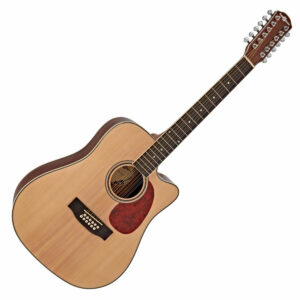 Body Wood: Spruce top with sapele back and sides
Body Wood: Spruce top with sapele back and sides- Neck: Nato
- Fingerboard: Poplar Laminate
- Scale Length: 648mm
- Pickups: None
- Bridge: Maple
- Tuners: Chrome
| Pros | Cons |
| Affordable price point for a 12-string guitar | The wider neck and string spacing on a 12-string guitar may be challenging for some players, especially beginners |
| Great for adding texture and depth to arrangements | The larger size of the guitar may be uncomfortable for smaller players |
From the mesmeric intro to “Hotel California” by the Eagles to the enchanting “Norwegian Wood” by the Beatles, 12-string acoustics have featured some truly classic music.
With twice the usual number of strings (each tuned an octave up), they create complex and shimmering sounds which can add tonnes of depth to a mundane song.
The Dreadnought 12 String by Gear4Music is ideal for experimenting with the textures of additional strings. Offering the traditional 12-string sound at a highly affordable price, this beginner-friendly acoustic suits newcomers to extended-range guitars to start expanding their musical repertoires.
Now, we say “beginner-friendly”, but, more strictly, it’s friendly for beginners to 12-string guitars as it’s not recommended to start here if you’re a complete newcomer to the guitar.
That’s for a few reasons: the neck is wider to accommodate the extra strings, meaning you’re required to stretch your hands even more to hit certain notes. On top of that, the necks are usually thicker to account for the extra string tension. And of course, twice the number of strings means twice the number to replace, maintain, and retune!
But if you’ve already mastered the basics and are looking for layered and immersive sound, then the Gear4Music dreadnought 12-string has it in spades!
That dreadnought body provides a large voice with plenty of punch and power, while the spruce top articulates each note in pristine clarity. And with chrome tuners keeping a lock on your stability, you can strum to your heart’s content without constantly reaching for the headstock.
Shop now | Dreadnought 12 String Acoustic Guitar by Gear4music
Things to consider
Size of guitar
The size of your guitar is incredibly important as it affects the playability, comfort, volume, and tone of the instrument.
Ultimately, the right size for you depends on comfort and your preferences. For example, a larger player with bigger hands may find themselves cramped on smaller, shorter-scale models. However, younger developing players might struggle to enjoy playing a dreadnought shape with steel strings.
Typically, larger guitars produce fuller sounds with deeper bass and a more powerful volume, great for strumming and performing unplugged. As you reduce the body size, the tone gradually becomes brighter and more treble-focused – to the point where parlour-style guitars are renowned for their fingerpicking clarity.
Tonewood
Tonewoods refer to the materials a guitar is made from – specifically on the body. While the neck and fretboard are important for playability, it’s arguable that their impact on tone is less important when compared to the body.
Typically, the most common tonewoods are spruce and mahogany, owing to their economic efficiency and great tonal properties. Spruce is by far the most used soundboard or top wood, while mahogany is usually found on the back, sides, and necks (but can also feature as a top wood).
Beginner guitarists should focus on whether the wood is laminate or solid. Laminate woods are made with thin sheets of layered wood and are often featured on budget models – even the budget models of higher-end brands.
That’s not necessarily a bad thing because laminate woods also provide great durability and resistance to moisture and humidity. What they sacrifice, however, is the full and rich tonality of solid woods. As solid woods are entirely an organic material, they’ll age and develop as the moisture content reduces throughout the years – mellowing and sweetening the sound.
Low action
The action of a guitar refers to the height of the strings. On electrics, this is easily adjustable, but on acoustics, it’s a little trickier. That’s why any model that advertises a “lower” action is great for beginners because it requires less effort in pressing the string.
Budget
It’s always an essential consideration. You could be the best player in the world, but those six-string beauties come at a cost. Luckily, even the biggest brands produce acoustics to fit virtually any budget, and with our list including names like Fender, Yamaha, and Epiphone, you can be confident of quality, whatever your price limit is.
Electronics
Some guitars (electro-acoustics) include electronic pickups and preamps to amplify your tone – just like an electric guitar. The style of electronics varies between guitars, with three main types of pickups and different styles of preamps, each offering a different kind of amplified performance.
In general, any electronics on acoustics will do their best to reproduce the natural acoustic voice of your guitar when you’re hooked up to an amp or PA or if you’re recording through an audio interface. This means electro-acoustics are great for gigging and laying down tracks with as they cut out the need for a proper microphone set-up.
Preamps often include built-in tuners which are fantastic for beginners, as they’ll help develop your ear for pitch and negate the need for a separate tuning device.
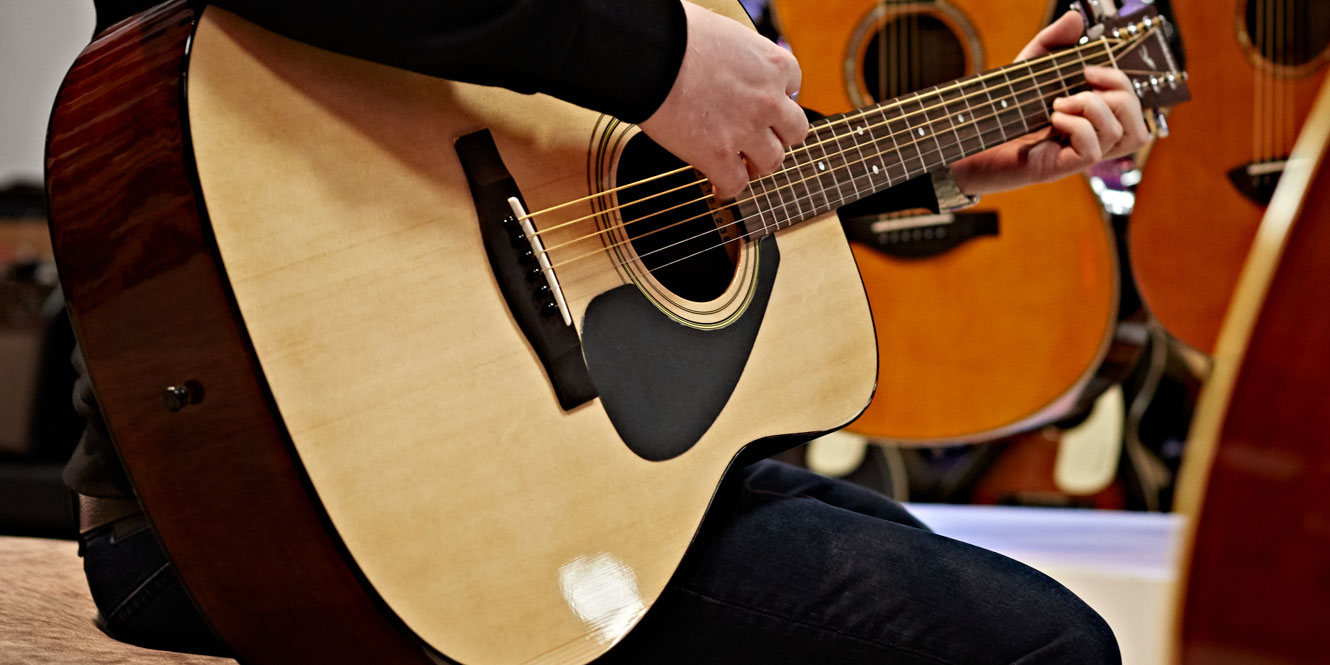
How to start learning acoustic guitar
Starting any hobby or discipline from scratch is a daunting process. Fortunately, learning the guitar now is easier than it ever has been before!
With an abundance of beginner-focused models to pick from, online tuition like Fender Play, free YouTube tutorials, and mountains of fan-created tablature guiding you through your favourite songs, there’s plenty of material out there to aid your practice. Even more traditional methods like music books and in-person lessons still exist, so you’re covered for whatever type of learner you are.
And of course, practice. Gotta do it, nothing beats it, it’s the golden rule for getting better at anything.
Is there an age limit?
You’re never too old or too young to start learning guitar! Well… that’s not strictly true, babies might struggle to shred solos after all, but in general there are no bars for any potential player. We’ve shown in this list that guitars come in all shapes and sizes, so no matter your stature or age, there’s a six-string out there waiting for you.

FAQs
What acoustic guitar brand is best for beginners?
For beginners, Yamaha and Fender are reliable acoustic guitar brands. They offer affordable, quality guitars that are easy to play and produce good sound. Other great brands for beginners include Epiphone, Tanglewood, and Washburn.
What is the easiest acoustic guitar to play?
The easiest acoustic guitar to play is one with a smaller body and neck, like a parlour or concert-style guitar. Nylon-string guitars are also easier to play due to their lower tension strings. Finally, models with low action and slimmer neck shapes boast the easiest playability.
What is a good price for a beginner acoustic guitar?
A good price range for a beginner acoustic guitar is around £100-£300. At this price range, you can find decent-quality guitars with good playability, sound, and components. Brands like Yamaha, Fender, and Epiphone offer affordable options for beginners that fit the price range.
Final thoughts
There you have it! A selection of the best guitars for beginners, with different shapes and styles to account for a range of tastes and player sizes.
Whether you’re chasing the sound of your favourite artist or looking for an entirely new instrument to challenge yourself with – this list of affordable models will serve you well for the early years and beyond!
And if you’d like to learn about the other types of guitars out there, why not give our guide a read? Once you’ve picked up your new six-string, you’ll need some songs to learn on it too – which is why we’ve also produced this list of 27 easy beginner guitar songs, with some playing tips included too!
If you have any questions, leave a comment below.













I’m looking for a light-weight guitar small for young players, 10-15 preferably, good sound, and cheap price. Any ideas I could get a guitar like that?
Hi Lily,
It really depends on the sound that the player prefers, and if they’re a total beginner – or just looking to try out an acoustic.
The Hartwood Prime with cutaway covers most of those bases if they want a steel string sound – it’s cheap, has a solid spruce top for a good tone, and comes with premium strings out of the box.
It might be a little big for younger player closer to age 10 though.. in which case, the Junior classical style guitar by Gear4music might be a better starting point.
The good thing about the larger guitars is that the players will usually grow into them!
Hope that helps,
Mark